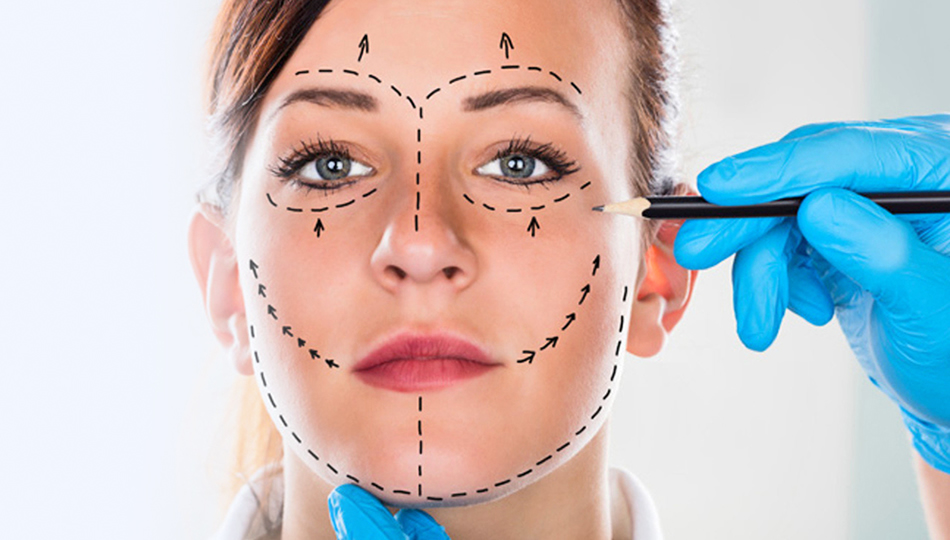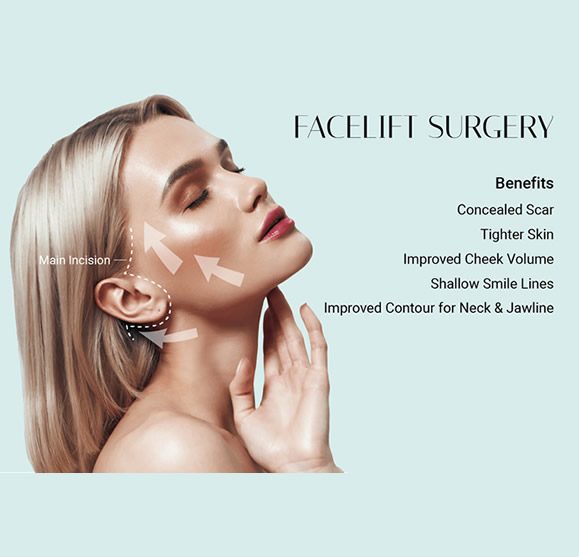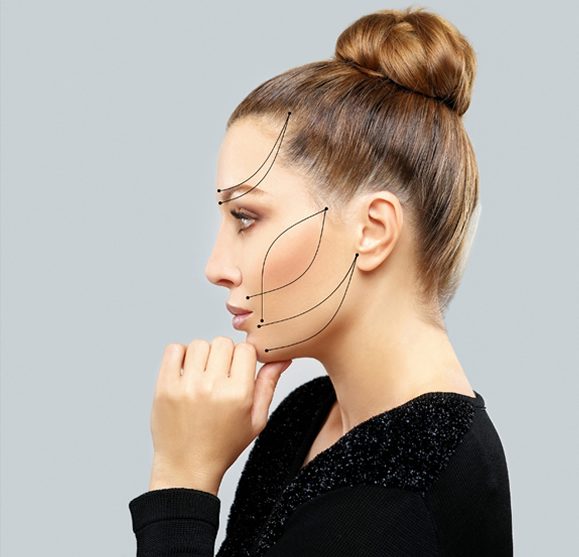WHAT IS FACELIFT?
A facelift, scientifically referred to as a rhytidectomy, is a transformative surgical procedure designed to address the signs of aging in the face and neck. This encompassing cosmetic surgery involves the meticulous repositioning or removal of sagging skin, fat, and muscle to achieve a revitalized appearance.
Wherever the lift is needed, the surgeon is separating the skin from the underlying fat and muscle. After the removal of the fat, the surgeon is elevating the supporting fascial layers of the face. The surgeon is pulling the skin back and so the excess skin is removed.
It’s important to note that facelifts are personalized cosmetic restorative procedures tailored to individual facial characteristics and desired outcomes. While they significantly improve signs of aging, they do not alter fundamental features or halt the natural aging process. Facelifts do not target superficial wrinkles, sun damage, or skin color irregularities.
Facelift surgery, goes beyond just turning back the clock—it helps patients look and feel like a rejuvenated version of themselves. By eliminating excess, sagging skin, smoothing deep folds, and lifting and tightening deep facial tissues, a facelift not only makes a patient appear younger but also enhances their overall facial aesthetic

WHY CHOOSE A FACELIFT

WHY CHOOSE A FACELIFT
As the natural aging process unfolds, our skin undergoes changes such as reduced elasticity and a gradual loss of facial volume. These transformations can lead to the emergence of “jowls,” deep wrinkles, and loose skin on the neck. While aging is a natural and inevitable part of life, individuals bothered by these signs may find a facelift to be a transformative solution.
The Aging Process and Facelift Candidacy:
As we age, factors such as diminishing skin elasticity, drooping facial muscles, and sagging skin become more pronounced. Genetics, daily life stresses, gravity, sun exposure, and drastic weight loss contribute to the aging process. A facelift is most effective when the face and neck exhibit signs of sagging, and the skin retains some elasticity with a strong, well-defined bone structure.
Facelifts are commonly sought by individuals in their 40s to 60s, although successful procedures can be performed on those in their 70s or 80s. The goal is not to create an obvious transformation but to impart a younger, healthier, lively, and cheerful appearance.
Choosing a facelift is an empowering decision, allowing individuals to harmonize their external appearance with their inner vitality. At TWT Health Tourism, we prioritize personalized care, guiding you through the transformative journey towards rediscovering your youthful radiance.
1- Traditional Facelift:
- Procedure: Involves incisions around the ears, hairline, and below the chin.
- Targets: Addresses moderate to significant facial aging by tightening muscles and supporting structures.
2- SMAS Facelift (SMAS Rhytidectomy):
- Procedure: Targets the lower two-thirds of the face, involving the superficial musculoaponeurotic system (SMAS).
- Focus: Tightens muscles, trims excess skin, and addresses cheeks and lower face.
- Addresses moderate to advanced aging around the mid-face and neck.
- Extensive surgery with incisions behind the hairline, achieving dramatic results.
- Repositions deeper tissues to eliminate jowling, sagging skin, and restore youthful contours.
3-Deep Plane Facelift:
- Procedure: Lifts SMAS, fat, and skin as a single unit for comprehensive facial rejuvenation.
- Coverage: Addresses multiple areas simultaneously for a holistic result.
- Repositions deeper tissues, including muscles, for thorough lifting without excessive skin tension.
- Achieves longer-lasting results compared to traditional methods.
- May involve repositioning fat pads for a lifted mid-face appearance.
4-Mid-Facelift:
- Procedure: Targets the cheek area by repositioning fat and tightening cheek skin.
5-Mini-Facelift:
- Ideal for mild jowling and sagging skin.
- Less invasive, utilizing shorter incisions.
- Targets deep facial tissues, refining the jawline and addressing signs of aging.
- Can be performed with local anesthesia or sedation, delaying the need for more extensive surgery.
- Procedure: Focuses on the lower face and neck, offering a quicker, less invasive alternative.
- Recommendation: Suitable for younger individuals with early signs of sagging.


Procedure Steps:
1. Anesthesia:
- Your surgeon will administer either general anesthesia (putting you to sleep) or IV sedation based on your unique requirements and the type of facelift chosen.
2. The Incision:
- Depending on the selected facelift type, incisions are strategically made in specific areas such as:
- In your hairline at your temples.
- Around your ears.
- At your lower scalp.
- Under your chin.
- In your mouth.
- The size and placement of incisions vary, tailored to the chosen facelift approach. Your surgeon will discuss these details with you before the surgery.
3. The Procedure:
- Facelift procedures typically involve repositioning and/or removing facial skin and/or fat while tightening facial muscles.
- The surgeon may perform one or a combination of these actions based on the selected facelift type. Detailed discussions with your surgeon will precede the surgery to clarify the chosen approach.
4. Closing the Incisions:
- After the transformative steps, your surgeon will close the incisions using one of the following options:
- Dissolvable stitches.
- Stitches that require removal after a few days.
- Skin glue.
Possible Complications of Facelift:
While facelifts are generally safe, complications can occur. Risks include anesthesia issues, infection, wound healing problems, hematoma, changes in skin sensation, facial nerve injury, temporary or permanent hair loss, scarring, and prolonged swelling. Important considerations include the temporary nature of results, inability to change fundamental appearance, and the importance of selecting a board-certified surgeon.
What to expect after the Facelift?
Facelift recovery generally involves swelling, bruising, and discomfort for several weeks. Stitches are usually removed after 7-10 days. Full results become evident within 3-6 months as swelling subsides. Facelifts offer significant improvements in facial contours, reducing wrinkles, tightening skin, and restoring a youthful appearance.
- Patients typically resume normal daily activities within about 2 weeks, with strenuous exercise postponed for approximately 4 weeks after a standard facelift. Mini facelifts often have even shorter recovery periods.
- Each patient’s healing process is unique, and your cosmetic surgeon will provide detailed aftercare instructions tailored to your specific needs.
2. Post-Surgery Concerns:
- Bruising and Swelling:
- Bruising and swelling peak around 2 days after surgery but gradually subside. After 10 to 14 days, they should be significantly reduced.
- Many patients feel comfortable going out in public within a week or so after the procedure, and camouflage makeup can be used to conceal any residual discoloration.
3. Protecting Your Face:
- Sun Protection:
- As you ease back into your routine, it’s crucial to shield your face from the sun. Sunburn vulnerability lasts for several weeks post-surgery.
- Wearing a wide-brimmed hat and applying sunscreen regularly is essential for optimal scar healing and protection.
4. Sensations and Activities:
- Numbness and Sensitivity:
- Some numbness in the cheeks and ears is normal and typically improves in a few weeks or months. Long-term sensitivity loss may occur in front of the ears.
- Keeping your head elevated, especially during sleep, helps reduce swelling.
- Post-Surgery Activities:
- Light activities are encouraged after two weeks, while strenuous activities, saunas, and massages should be avoided for at least two weeks.
- Puffiness and stiffness are common initially, but these effects subside over time.
5. Scar Management and Appearance:
- Camouflage Makeup:
- Camouflage makeup can be used to cover bruising during the recovery period.
- Scars, typically well-hidden in the hairline, may require shorter hair around the wound. Men may find it slightly more challenging to conceal scars due to beard growth adjustments.
- Hair Growth and Scarring:
- There might be a slight reduction in hair growth in the temples, but this is usually not problematic unless the hair is very thin and multiple facelifts are performed.
- Scars in the hairline are discreet, and the hair will have been cut shorter immediately around the wound.
6. Post-Surgery Precautions:
- Avoid Heavy Lifting and Bending:
- Heavy lifting is discouraged for several weeks, and bending down or engaging in vigorous activities should be approached gently.
- For at least two weeks, avoid sex and take precautions during daily activities.
- Driving Considerations:
- Resume driving when you feel safe and comfortable wearing a seatbelt. Verify with your insurance documents if needed.

Why TWT Health Tourism?
Turkey Wellness Tourism (TWT) is a leading health tourism company that offers affordable, safe, and hassle-free medical treatment in Turkey. We work with a network of 122 specialist doctors and 36 healthcare providers in the country’s four largest cities: Ankara, Istanbul, Izmir.
Our contracted hospitals and clinics are accredited to national and international standards, such as JCI, TEMOS, CE, and TSE. This ensures that our clients receive the highest quality care in a safe and hygienic environment.
At TWT Health Tourism, we are dedicated to understanding our patients’ needs. All of our treatment plans are personalized for individuals, prioritizing your needs and benefits above everything else.
What to expect from TWT Health Tourism
At TWT Health Tourism, we understand that embarking on a medical journey can be overwhelming, which is why we strive to make the process as seamless and comfortable as possible for our patients.
1- From the initial stages of pre-consultation, we serve as the perfect bridge between you and the healthcare providers. Our dedicated team ensures that you receive all the necessary information and guidance to make informed decisions about your treatment options.
2- Throughout the healing process, we provide continuous support and follow-up care to ensure that you never feel alone. Our team remains by your side, offering assistance, guidance, and reassurance every step of the way.
3- We recognize the importance of accessibility and communication, which is why we are available round-the-clock to address any concerns or questions you may have. Whether it’s about your treatment plan, recovery process, or logistical arrangements, we are here to provide prompt and comprehensive assistance throughout your entire journey.
At TWT Health Tourism, your comfort and well-being are our top priorities, and we are committed to making your medical journey a smooth and positive experience from start to finish.
Focused On You
As our valued patient, you are at the center of everything we do – and that will never change.
24/7 Care
Open every day from 8 – 8, with no appointments necessary. Just walk in at a time that works best for you.
Timely Care
We know how busy life can be. That’s why most patients are in and out in less than an hour.





